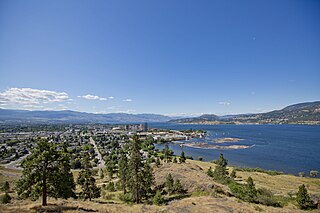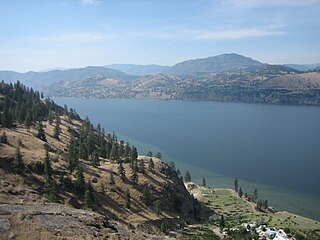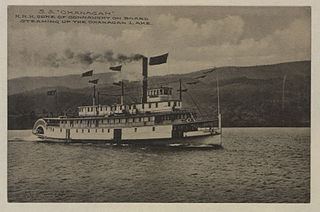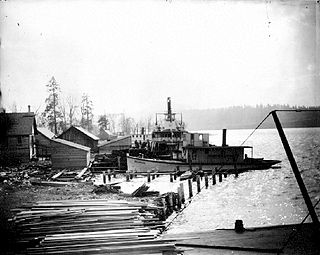Related Research Articles

Kelowna is a city on Okanagan Lake in the Okanagan Valley in the southern interior of British Columbia, Canada. It serves as the head office of the Regional District of Central Okanagan. The name Kelowna derives from the Okanagan word kiʔláwnaʔ, referring to a grizzly bear.

Okanagan Lake is a lake in the Okanagan Valley of British Columbia, Canada. The lake is 135 km (84 mi) long, between 4 and 5 km wide, and has a surface area of 348 km2.

The Okanagan, also called the Okanagan Valley and sometimes the Okanagan Country, is a region in the Canadian province of British Columbia defined by the basin of Okanagan Lake and the Canadian portion of the Okanagan River. It is part of the Okanagan Country, extending into the United States as Okanogan County in north-central Washington. According to the 2016 Canadian census, the region's population is 362,258. The largest populated cities are Kelowna, Penticton, Vernon, and West Kelowna.

Skaha Lake is a freshwater lake, through which the Okanagan River flows, in the Okanagan region of south central British Columbia. Along the shoreline are Penticton (north), Kaleden (west), and Okanagan Falls (south).

Okanagan Valley Railway was a railroad operating former Canadian Pacific Railway track in the Okanagan region of British Columbia, Canada. Service commenced on November 22, 1998. OKAN's line ran from a CP connection at Sicamous to Vernon. It also had trackage rights on Kelowna Pacific Railway's line from Vernon to Kelowna and from Lumby Junction to Lumby. The railroad was owned by OmniTRAX.
Okanagan Landing was an unincorporated settlement and steamboat port at the north end of Okanagan Lake in the Southern Interior of British Columbia. Located southwest of the city of Vernon, it was the terminus station for the Shuswap and Okanagan Railway and served as the port and shipyard for steamboats operating to the south, as well as a transfer barge slip.

SS Naramata is a steam tug commissioned by the Canadian Pacific Railway (CPR) company. She pushed barges and broke ice on Okanagan Lake from 1914 to 1967. After over 50 years of service, the boat was eventually retired and left to rest in Penticton beside her sister ship, SS Sicamous. In 2001, she was purchased by the S.S. Sicamous Restoration Society and is currently undergoing extensive renovations. Naramata is the only interior steam tug to be preserved in the province of British Columbia, Canada.

SS Okanagan was a steamship owned and operated by the Canadian Pacific Railway Lake and River Service. The vessel was constructed in 1906 at Okanagan Landing and launched in 1907, becoming Okanagan Lake's second steamship. She linked the transportation hubs at both the north and south ends of Okanagan Lake (Vernon and Penticton, respectively, aiding the development of interior British Columbia with other steamships of the 1900s. The ship was retired in 1934 and sold for scrap and spare parts. Only the Stern Saloon, a room in the back of the upper deck, remains. It was moved to the SS Sicamous Heritage Park in Penticton in 2002, to undergo restoration work.

SS Aberdeen was a steamship commissioned by Canadian Pacific Railway company. It was the first CPR steamship on Okanagan Lake and carried passengers and cargo from Okanagan Landing to Penticton from 1893 to 1919. Aberdeen connected communities along Okanagan Lake for the first time, creating a new era in the Okanagan Valley and greatly aiding the economy and settlement of the interior of British Columbia.

Canadian National Tug no. 6 was a diesel-powered tugboat owned and operated by the Canadian National Railway (CNR) company on Okanagan Lake, British Columbia. It was launched in 1948 and transferred railway barges between Penticton and Kelowna. It was retired in 1973, becoming the last of many tugboats to operate on Okanagan Lake. Tug 6 was moved to Penticton in 2007 to rest alongside the SS Naramata and SS Sicamous, two Canadian Pacific Railway (CPR) steamboats, as part of the S.S. Sicamous Inland Marine Museum. The ships are currently being restored by the S.S. Sicamous Restoration Society.
MV Okanagan was a tugboat that operated on Okanagan Lake, Penticton, British Columbia, from 1947 to 1972. It was the largest and last Canadian Pacific-operated tugboat on Okanagan Lake and its retirement marked the end of Canadian Pacific’s service on B.C.’s inland lakes and rivers, as well as 80 years of service on Okanagan Lake. During service, the Okanagan pushed railway barges up and down the lake and broke ice during winter.
MV Pentowna was a motor ship that transported passengers, and later freight, on Okanagan Lake from 1926 to 1973. It was the first boat to be owned and operated by Canadian National Railway (CNR) on Okanagan Lake and the first diesel-powered boat on the lake. Pentowna served the communities between Kelowna and Penticton with two daily round trips, aiding the development of the Okanagan Valley with its modern technology and speed.

SS Kelowna was a tow boat that was operational between the years 1892–1912 on Okanagan Lake in British Columbia. It was later dismantled in Penticton.

Castlegar was a wooden-hulled tugboat for the Canadian Pacific Railway company. Built in 1911 at Okanagan Landing, its purpose was to handle railway car barges on Okanagan Lake. The Castlegar was a significant improvement over existing vessels in the Okanagan for service at the time.

SS Whatshan was a steam tug owned by Canadian Pacific Railway that operated on the Lower Arrow Lakes in British Columbia, Canada from 1909 to 1919. Although she was small, she proved to be the most suited to the Lower Arrow Lake run of all the tugs on the route from 1909 to 1961 because she had enough power to keep the channel open in bad weather when other ships became stranded in ice.
MV Aricia was a ferry that operated on Okanagan Lake in British Columbia, Canada. She was built in 1912 by J. Y. Campbell and was also known as the Kelowna-Westbank ferry, because she served the communities of Kelowna and Westbank, British Columbia.
SS Clovelly was a steam ferry that operated on Okanagan Lake in British Columbia, Canada. She was commissioned by Captain L. A. Hayman and built by DeFoe in Vancouver, British Columbia in the fall of 1907. She was named after Clovelly, a small village on the Bristol Channel in England. She was launched by Captain J. B. Weeks and began a service of two trips a week hauling lumber, feed, and fruit between the communities of Westbank, Bear Creek, and Kelowna. She was the fourth ferry on the lake. Shortly after her launch, it was discovered that her vertical boiler leaked, so a water tube boiler was built by A. Brunette of the Leckie Hardware Company of Kelowna. She was inspected and passed by J. H. Thompson, Dominion Government Steamboat Inspector for the Province. In 1911, Clovelly was sold to E. Hankinson. Complaints about poor service reached the government and Hankinson lost the charter. Clovelly went to J. Y. Campbell, who operated her from 1912 to 1916 and also built MV Aricia in 1912.
MV Cygnet was a 40 feet (12 m) by 10 feet (3.0 m) motor launch that provided ferry and freight service on Skaha Lake in British Columbia, Canada. She was built by Summerland Boat Works in 1911 for the South Okanagan Transportation Company, owned by James Fraser Campbell and A. S. Hatfield, to replace the tug Kaleden. Cygnet had a Fairbanks marine engine that was started by turning the flywheel with a steel bar that fitted into sockets in the wheel. In the early 1920s, she was moved to Okanagan Lake to carry fruit to Kelowna, British Columbia for a summer before she was sold in Kelowna.
MV Skookum, also known as Tut Tut, was a ferry that operated on Okanagan Lake in British Columbia, Canada starting on April 2, 1906. She was the first official, government-subsidized ferry on the lake to connect the communities of Kelowna and Westbank.
SS Wanderer was the second, unofficial ferry to serve Okanagan Lake in British Columbia, Canada.
References
- ↑ "C.N. and C.P. Marine Service in Kelowna: Tug and Rail Barge History from a Kelowna Perspective" . Retrieved 13 August 2015.
- ↑ Hatfield, Harley R. (1992). "Commercial Boats of the Okanagan". Okanagan history. Fifty-sixth report of the Okanagan Historical Society. pp. 20–33. Retrieved 2 Aug 2015.
- ↑ McKim, J. Claude (1984). "The Tug and Barge Service on Okanagan Lake". Forty-eighth annual report of the Okanagan Historical Society. p. 45. Retrieved 13 August 2015.
- ↑ Affleck, Edward L. Steamboating on the Columbia River System in British Columbia. Vancouver: Alexander Nicolls Press. 2002.